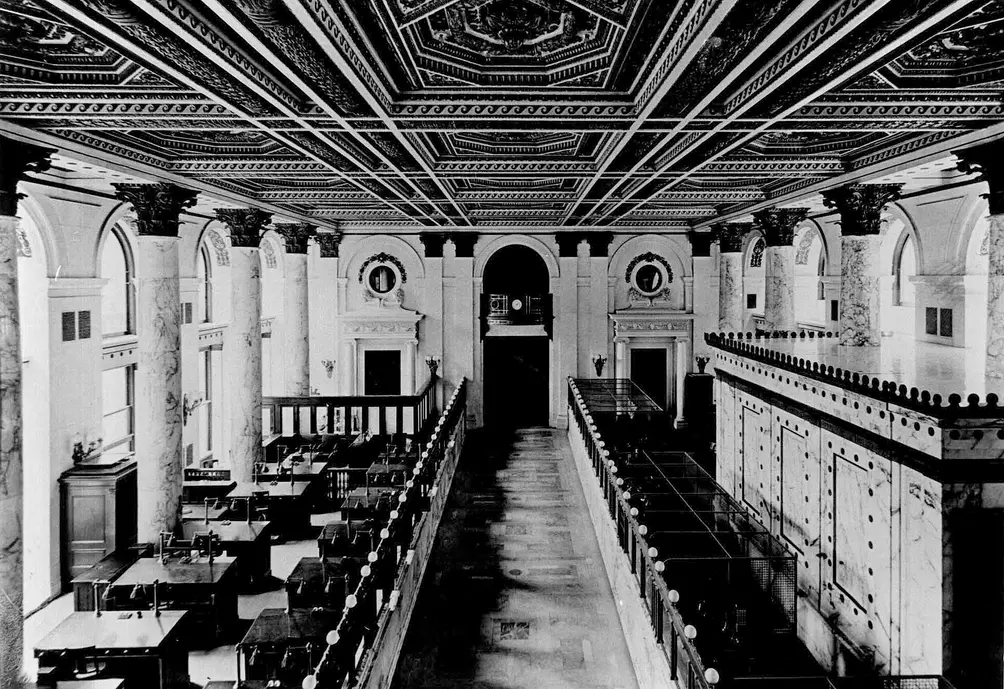The ornate Renaissance Revival landmarked building at 108 Leonard Street has most recently made headlines for the lawsuit surrounding the conversion of its clock tower into a triplex penthouse. Last year, the NYS Supreme Court upheld the decision by a Manhattan judge to maintain the clock’s accessibility to the public.
Prior to these conversion plans by Peebles Corporation and Elad Group, and even prior to its emergence as a New York City landmark and member of the National Register of Historic Places, 108 Leonard enjoyed an architectural prominence intertwined with the development of business in the late nineteenth and early twentieth centuries. Formerly the headquarters of the New York Life Insurance Company, the structure occupies the entire trapezoidal block bounded by Broadway to the west, Lafayette Street to the east, Leonard Street to the north, and Catherine Lane to the south, rooting the area into the historical landscape of the insurance business.
In this article:
According to a report by Nancy Goeschel of the Landmarks Preservation Committee's Research Department, The New York Life Insurance Company was initially chartered in 1841 as the Nautilus Insurance Company (58 Wall Street), offering its clients marine and fire insurance. The first policy was honored in 1846 when $225 was awarded to Alonzo Clark for his slave, Philip Swan. In fact, slave policies comprised 33% of the first 1,000 policies issued by the company, until their discontinuance in 1848.
One year later, the company officially penned its new name “New York Life Insurance Company.” Though early policies during this time required little medical information, they carried hefty restrictions. They were forfeitable, for example, in the events of death by suicide, war, duel, misadventure on the high seas, travel south of Virginia between July and November, and travel abroad. High premiums were slapped on those who joined the California Gold Rush, and in 1850 those who partook in “intoxicating drinks or opium” were considered “bad risks.” Women, classified under “substandard lives,” paid extra premiums due to childbirth mortality rates.
 New York City in 1848 from the steeple of St. Paul???s Church, Wall Street and the Nautilus Insurance Company would be off in the distance in the center of the photo ( The Edward W. C. Arnold Collection of New York Prints, Maps and Pictures, Bequest of Edward W. C. Arnold, 1954)
New York City in 1848 from the steeple of St. Paul???s Church, Wall Street and the Nautilus Insurance Company would be off in the distance in the center of the photo ( The Edward W. C. Arnold Collection of New York Prints, Maps and Pictures, Bequest of Edward W. C. Arnold, 1954)
While business prospered throughout the 1850s, New York Life emerged with humanitarian goals in 1860, becoming the first firm to offer a policy with a non-forfeiture clause. In 1873, the economic panic contributed to a decline in the number of competing companies and policies issued. New York Life emerged unscathed, and came to form a triumvirate known as the “Big Three” alongside the Equitable Life Assurance Company and the Mutual Life Insurance Company.
The nature of the insurance business was peculiar when compared to the other great standouts of the nineteenth century, such as the steel and railroad businesses. The insurance industry offered no tangible product or good, yet required more than tantamount levels of public trust. Those looking to invest sought established structures of integrity and permanence within the insurance company. This led to the furtherance of the term “institution,” as the companies implied their philanthropic motivations while becoming pioneers in modern advertising and public relations.
The power of architecture thus emerged as the means of instilling tangible confidence and goodwill in investment. After New York Life’s rival Equitable Life announced plans to construct a new bold headquarter on Broadway in 1868, the firm sought to expand its modest presence on Wall Street. That same year, New York Life acquired former publishing company Appleton’s site at 346 Broadway, which had recently caught fire. The company commissioned well-known architect of the time Griffith Thomas to design a new five-story office building. Constructed in white marble in the Italianate style, the building officially opened on May 1, 1870 (the same day that Equitable’s building debuted as the tallest building in the city).
In the following years, New York Life fully realized the connection between architecture and corporate image. During the 1880s, the company erected 11 impressive buildings throughout the nation and beyond, many of which were designed by prominent architects including McKim, Mead & White.
In the year 1893, New York Life decided to expand its headquarters, which at the time occupied half the trapezoidal block in between Broadway, Leonard, Lafayette (previously Elm) Streets and Catherine Lane. After acquiring the remaining property within the block, the company invited five prominent architectural firms to compete to create the desired 12-story expansion that would harmonize with the existing marble structure. Invited to participate were the New York-based Stephen D. Hatch; McKim, Mead & White; George B. Post; and Babb, Cook & Willard, as well as Chicago-based Daniel H. Burnham.
Amidst the contest, debates arose surrounding the commission rates for the winner. At this time, a 5% commission was considered standard, but New York Life was hesitant to specify this explicitly. Four of the five competing firms drafted written agreements to not accept less than a 5% commission. Hatch did not, and he emerged victorious, accepting a 3.5% commission rate. Not as well-known as his competitors, he perhaps opted for less due to eagerness for the work, and whether the competition committee preferred his design or his rate remains to be known.
In May 1894, the construction of Hatch’s design commenced. However, he suddenly died at the age of 55, three short months later. New York Life opted to hand the project over to McKim, Mead & White, while appointing Hatch’s successor William McCabe as General Superintendent of the project.
Suddenly displeased with the aesthetic of the impending extension, the company decided to demolish the pre-existing structure that Hatch had initially contended with in his design. McKim, Mead & White therefore set out to create a building with no discernable division between their contributions and Hatch’s.
 View of the general office on the ground floor before being destroyed (NYC Landmarks Preservation Commision)
View of the general office on the ground floor before being destroyed (NYC Landmarks Preservation Commision)
Spearheaded by project leader William Mead and young architect Henry Bacon, the new design called for a climactic focal point. This yielded the tall tower pavilion facing Broadway, achieving the overall architectural image the company sought: modern skyscraper heights and bold construction, married with permanence and tradition in its classical style.
The building stands twelve stories tall at its western end, rising to thirteen stories at its eastern end to accommodate the sloping land. Constructed mostly in white Tuckahoe marble, the building incorporates light-colored pressed brick with terrace cotta moldings on its Catherine Lane elevation.
The bell tower is three bay windows across on both sides, constructed of smooth rusticated marble with a monumental portico entrance and a crowning clock. Originally, the clock tower was topped by a bronze and galvanized steel sculpture, featuring four kneeling male figures supporting a skeletal globe beneath an eagle. Designed by architectural sculptor Philip Martiny, the structure was removed sometime following 1928.
In 1919, New York Life made plans to move its headquarters uptown in order to adhere with the northward progress of the city. Following the demolition of Madison Square Garden in 1925, they chose this site, selling their former headquarters at 346 Broadway to the City of New York. In 1967, the building became home to courts and government agencies before Elad Group and Peebles Corporation acquired it in 2013 with plans to convert to a luxury condominium.
While the clock tower portion of the building stands protected from conversion by court rulings, the remainder of the building will house 152 residences across its 13 stories. Following a sales launch earlier this year, there are currently 13 residences for sale, including four one-bedrooms starting from $1.58 million, five two-bedrooms starting from $2.475 million, three three-bedrooms starting from $4 million, and a four-bedroom for $5.975 million.
Residences feature design by Jeffrey Beers International, with details ranging from oversized moldings to chevron-patterned oak floors. Ceiling heights range from 10 feet to over 14 feet, kitchens come finished in a choice of either sand or ash palettes, and baths include Calacatta black feature walls.
20,000 square feet of amenities include rooftop gardens with cabana seating and outdoor dining, a 75-foot indoor pool, a 2,200-square-foot fitness center, and a wine cellar with a private dining room. The building also houses a commercial banquet space inside its former banking hall.
 Anticipated banquet space inside the former banking hall (Beyer Blinder Belle)
Anticipated banquet space inside the former banking hall (Beyer Blinder Belle)
Would you like to tour any of these properties?

Contributing Writer
Katy Cornell
Katy Cornell is a Long Island native with a passion for writing about real estate in the big city. She recently graduated from the University of Virginia with a BA in English and is a frequent contributor to CityRealty's Market Insight and NYC real estate blog 6sqft.


 6sqft delivers the latest on real estate, architecture, and design, straight from New York City.
6sqft delivers the latest on real estate, architecture, and design, straight from New York City.
